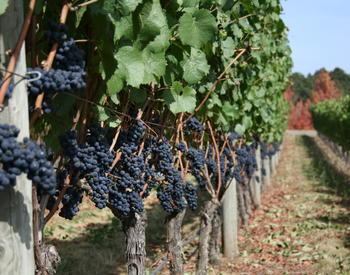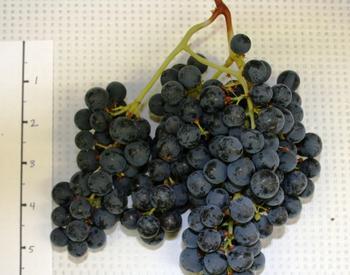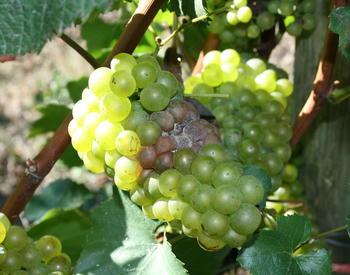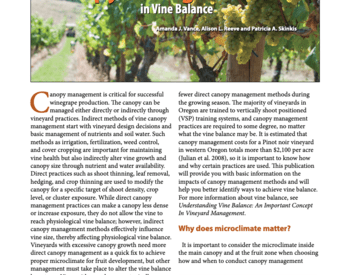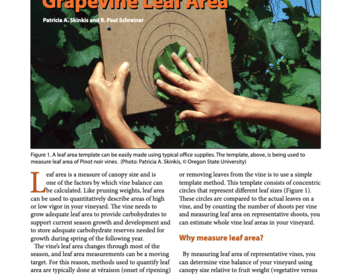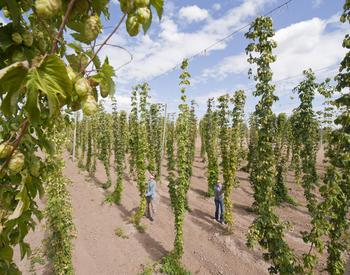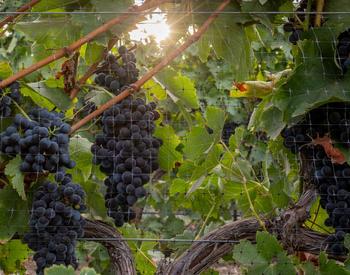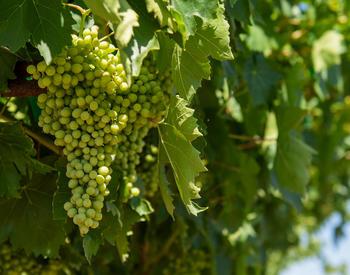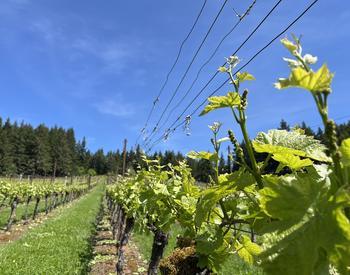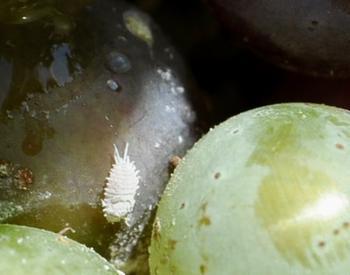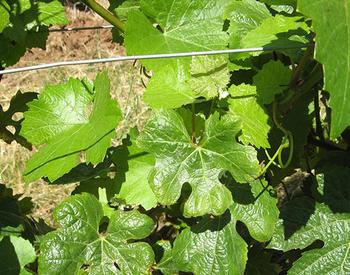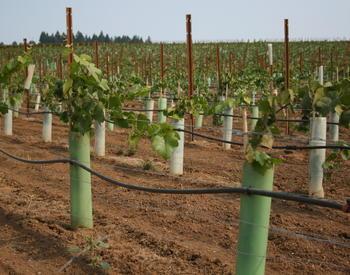Sulfur continues to be one of the most used fungicides in viticulture but has been associated with increased mite and insect problems and hydrogen sulfide formation during fermentation or aging. Efficacy data from other crops indicates that the sulfur rates employed in viticulture may be excessive.
Field and laboratory experiments were conducted to examine the use of reduced sulfur rates for the management of grape powdery mildew. Growth chamber experiments examined rate (0, 2, 4, 6 and 8 lbs/100 gal sulfur equivalent concentrations) and duration (plants inoculated 0, 6, 10, 14, and 21 days after sulfur application).
Leaf disease severity indicated that sulfur rate of greater than 2 lbs/100 gal (i.e. 0.8 to 1.6 lbs/A) would provide sufficient disease protection out to 21 days after application. Field trials indicated that 2 lb sulfur/100 gal provided the same leaf disease control as 8 lbs sulfur/100 gal (i.e. 3.2 to 6.4 lbs) over the course of a growing season. Assessment of fruit infection indicated that rate above 4 lbs sulfur/100 gal (i.e. 1.6 to 3.2 lbs/A) did not result in improved disease control. These data indicate that sulfur rates can be reduced without compromising disease control.
Introduction
Sulfur is the most commonly used pesticide in viticulture, regardless of conventional, organic, or biodynamic management approaches. Sulfur applications can have negative impacts on winemaking (Thomas, et al. 1993) and establishment and efficacy of biological control of arthropods(e.g., mites) (Walton, et al. 2007). In order to avoid sulfur residues on grapes, many growers use other fungicides post-fruit set; however, for organic production, there are few alternative fungicides and none are as economical or effective. Reducing the number of sulfur applications and/or rate of application would improve vineyard economics and sustainability.
Numerous observations indicate that current guidelines for sulfur use in viticulture result in too much production being applied due to excessive short application interval or high application rate. For instance, in hops 6 lb sulfur/A on 10-14 day spray interval is sufficient to manage hop powdery mildew (HPM) in an 18 ft canopy, which is equivalent to using 3.4 lb/A for 7 ft row spacing at full canopy in grapes.
Sulfur is thought to be non-volatile when temperatures are <18˚C; therefore, it may remain on leaves and grape clusters under spring conditions and in cooler climates (coastal regions) longer than has been measured in other grape-growing regions (Thomas, Gubleretal. 1993). It is also possible that brief periods of temperatures >64˚F are needed for sulfur to be active. There is also the possibility that volatilization occurs at ambient temperatures <64˚F if leaf surface temperature is > 64˚F due to sun exposure. Leaf temperatures as much as 23˚F above ambient have been observed on leaves in direct sunlight (Wilcox, personal communication).
These observations indicate that a systematic evaluation of sulfur activity across various temperature regimes and application methods could yield information on how to reduce sulfur use without compromising disease control. We are proposing a two-pronged approach that utilizes the efficiency of controlled environment studies to direct practical assessments in small field plots.
Objectives
- Evaluate different formulations, rates, time intervals and methods of sulfur application for control of grape powdery mildew.
- Validate results of controlled environment studies in small field plots.
Methods
Spore germination assay
- Glass slides with half covered with tape sprayed with sulfur.
- Tape removed and incubated at 70°F.
- Slides were placed in settling tower and inoculated with E. necator spores.
- Incubated at 72°F for 48 h, then observed microscopically.
- Germinated and ungerminated spores were examined 2mm, 5mm, 9mm, and 14mm away from the sulfur on the sulfur-free half of the slide and 5mm, 15mm, and 25mm into the sulfur zone.
Growth chamber plant assay
- Chardonnay seedlings with >5 leaves were sprayed with sulfur and then incubated at 70°F for 0, 6, 10, 14, or 21 days.
- Placed were placed in settling tower and inoculated with E. necator spores.
- Incubated at 72°F 10 to 12 days before rating for percent disease leaf area.
- Germinated and ungerminated spores were examined 2mm, 5mm, 9mm, and 14mm away from the sulfur on the sulfur-free half of the slide and 5mm, 15mm, and 25mm into the sulfur zone.
Field efficacy
- Five vine plots consisting of 12-year-old vines of Pinot Noir clone 2A on 420A rootstock planted on 5-by-6-foot spacing with bilateral canes trained in a VSP.
- Sulfur applications initiated when airborne E. necatorinoculum was detected.
- Rates were 0, 2, 4, 6, or 8 pounds sulfur mixed with 100 gallons of water. Volume applied varied based on canopy growth.
- Applied using a ducted over-the-row sprayer with venturi nozzles.
- 10 leaves from 5 vines assessed every 2 weeks.
Conclusions
- Sulfur applications of less than 4 lbs/A were sufficient to manage grape powdery mildew on leaves and fruit.
- Sulfur applications have a long residual in the absence of rainfall under temperatures below 86°F.
- Further testing is required to examine the effects of diurnal temperature fluctuation.
References
Thomas, C. S., R. B. Boulton, et al. (1993). "The Effect of Elemental Sulfur, Yeast Strain, and Fermentation Medium on Hydrogen Sulfide Production During Fermentation." American Journal of Enology and Viticulture 44(2): 211-216.
Thomas, C. S., W. D. Gubler, et al. (1993). "Changes in Elemental Sulfur Residues on Pinot Noir and Cabernet Sauvignon Grape Berries During the Growing Season." American Journal of Enology and Viticulture 44(2): 205-210.
Walton, V. M., A. J. Dreves, et al. (2007). "Relationship between rust mites Calepitrimerus vitis (Nalepa), bud mites Colomerus vitis (Pagenstecher) (Acari: Eriophyidae) and short shoot syndrome in Oregon Vineyards." International Journal of Acarology 33: 307-318
Funding
USDA-ARS CRIS# 5358-22000-034-00D and North West Center for Small Fruit Research
